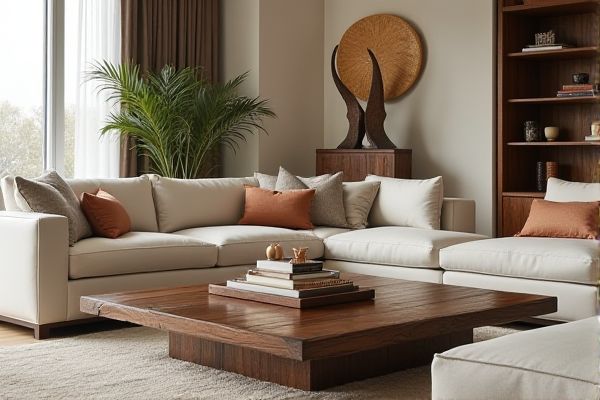
Decorative sculptures enhance your living space by adding artistic value and aesthetic appeal without serving a practical purpose. Discover how to balance style and utility by exploring the distinctions between decorative sculpture and functional decor in the rest of this article.
Table of Comparison
| Feature | Decorative Sculpture | Functional Decor |
|---|---|---|
| Purpose | Artistic expression, visual appeal | Utility combined with aesthetics |
| Functionality | Primarily ornamental | Serves practical use (e.g., storage, lighting) |
| Examples | Statues, figurines, wall art | Lamps, decorative bowls, furniture |
| Material | Stone, metal, clay, glass | Wood, metal, ceramic, fabric |
| Placement | Display areas, shelves, pedestals | Living spaces, work areas with functional needs |
| Visual Impact | Focus on form, texture, color | Balance between form and function |
Introduction to Decorative Sculpture and Functional Decor
Decorative sculpture enhances interior and exterior spaces by focusing on aesthetic appeal and artistic expression, often crafted from materials such as bronze, marble, or resin. Functional decor combines utility with design, including items like decorative shelves, artistic lamps, and ornamental furniture that serve practical purposes while contributing to a room's visual appeal. Understanding the balance between purely decorative sculptures and functional decor pieces is essential for creating harmonious and purposeful environments.
Defining Decorative Sculpture
Decorative sculpture emphasizes artistic expression and visual appeal, serving primarily as an ornamental element that enhances your space without practical use. Unlike functional decor, which combines aesthetics with utility--such as decorative bowls or bookends--decorative sculptures focus solely on evoking emotion or showcasing craftsmanship. These artistic pieces often highlight materials, textures, and forms designed to captivate attention and complement interior design styles.
Understanding Functional Decor
Functional decor integrates aesthetic appeal with practical use, enhancing living spaces while serving specific purposes such as storage, lighting, or seating. Unlike purely decorative sculpture, functional decor balances design and utility, often incorporating elements like shelves, lamps, or furniture that contribute meaningfully to daily life. This dual role not only elevates interior style but also maximizes spatial efficiency by combining beauty and function seamlessly.
Historical Evolution of Art and Functionality
Decorative sculpture has evolved from purely ornamental pieces in ancient civilizations to complex expressions of cultural identity, while functional decor originated as practical objects integrating artistic design to enhance everyday life. Throughout history, societies have balanced aesthetic appeal and utility, with artifacts like Greek pottery and Renaissance furniture exemplifying this fusion. Your appreciation for art can deepen by understanding how historical contexts influenced the shifting roles of decoration and function in design.
Material Choices: Aesthetic Vs. Practicality
Decorative sculpture often utilizes materials like bronze, marble, and glass to emphasize aesthetic appeal, prioritizing intricate designs and textures that enhance visual impact. Functional decor favors durable and practical materials such as wood, metal, and ceramics, balancing beauty with usability to withstand everyday wear. Material choices reflect the intended purpose, where decorative sculptures accentuate artistic expression while functional decor integrates form with utility.
Artistic Expression: Statement Piece or Utility?
Decorative sculpture serves as a powerful medium of artistic expression, often crafted as a statement piece that evokes emotion and enhances a space's visual appeal. Functional decor balances aesthetics with utility, integrating practical elements like lighting or storage while maintaining artistic design. Both forms enrich interiors, but decorative sculptures prioritize creative impact, whereas functional decor emphasizes purposeful design.
Integrating Styles: Blending Sculptures with Everyday Items
Blending decorative sculptures with functional decor enhances your living space by creating a harmonious balance between art and utility. Integrating sculptures with everyday items like shelves, tables, or lighting fixtures adds visual interest while maintaining practicality. This fusion of styles allows for a personalized environment where aesthetic appeal meets purposeful design.
Space Considerations: Display vs. Use
Decorative sculptures prioritize aesthetic appeal and often require prominent display areas to enhance visual impact, making them ideal for spaces where appearance is the main focus. Functional decor balances beauty with utility, necessitating strategic placement to ensure accessibility and practicality without sacrificing design elements. Optimizing space involves considering both the sculpture's visual footprint and the functional object's role in daily use to create harmonious environments.
Value and Investment: Art for Pleasure or Practicality
Decorative sculptures often hold significant aesthetic and emotional value, making them prized investments for personal enjoyment and cultural enrichment. Functional decor combines artistic appeal with utility, providing practical benefits alongside visual enhancement, which can increase your living space's overall value. Choosing between these depends on whether you prioritize art for pleasure or practicality, as decorative pieces tend to appreciate in value, while functional decor offers everyday usability.
Choosing What Suits Your Space
Choosing the right balance between decorative sculpture and functional decor depends on your space's purpose and style. Decorative sculptures add artistic flair and express personality, while functional decor enhances usability, like stylish storage or lighting elements. Assess room size, lighting, and existing furnishings to determine if sculptural pieces serve as focal points or if functional items better support daily activities.
 homyna.com
homyna.com